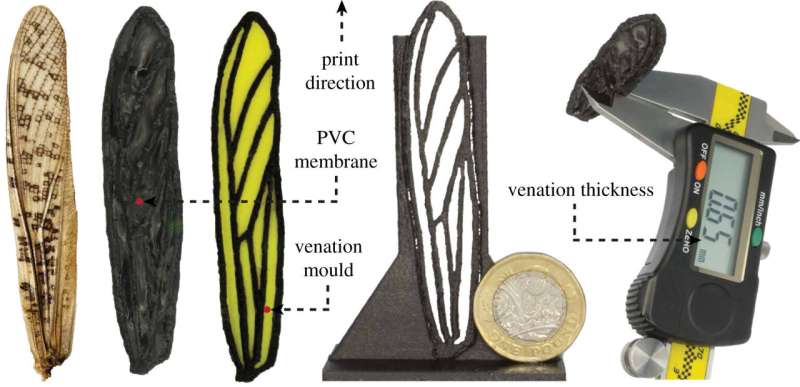3D printed locust-inspired forewing preparation process from left to right: actual locust forewing, finalized 50 μm PVC reinforced forewing prototype (CF-PETG-1), venation pattern mould, 3D printed forewing exoskeleton, and the measured average profile thickness. Credit: Royal Society Open Science
A team of researchers from the University of Lincoln in the U.S. and Huazhong University of Science and Technology and Guangzhou University, both in China, has developed a way to manufacture drone wings with locust wing properties, allowing drones to glide for long distances. In their paper published in the journal Royal Society Open Science, the group describes how they developed their technique and how well it worked when tested.
Prior research has shown that locusts are able to fly long distance because they are able to take advantage of air currents and their species' swarming characteristics. Prior research has also shown that mimicking natural creatures can sometimes reap rewards when building human machines. In this new effort, the researchers began with the idea that drones or airplanes with some of the features of locusts might be better at gliding, a feature airplane makers covet because it can result in reduced fuel consumption and also a reduction in noise. But instead of designing a plane with locust-inspired wings, the researchers looked at several of the features of locust wings and developed ways to manufacture copies that take advantage of their special properties, for both drones and small airplanes.
To learn more about the features that might make human-made flying machines better gliders, the researchers closely studied the features of locust wings that allow them to glide so well. Noting that locust wings are made of very thin and lightweight material with specific vein patterns (for carrying haemolymph) they created digital 3D reproductions of them, and then made them bigger. They next used the images to create molds that could be used to create thermoformed wings. The wings were then trimmed using a laser and etched to reproduce the patterns found on locust wings. The team then made several prototypes with different thicknesses and weights, as a way to find out which had just the right amount of stiffness.
Testing of their manufacturing process showed that it was a viable way to produce usable wings for both drones and small aircraft. More work will need to be done to verify that such craft experience benefits from the locust-inspired wing design.
More information: Hamid Isakhani et al, Towards locust-inspired gliding wing prototypes for micro aerial vehicle applications, Royal Society Open Science (2021). DOI: 10.1098/rsos.202253
Journal information: Royal Society Open Science
© 2021 Science X Network
























